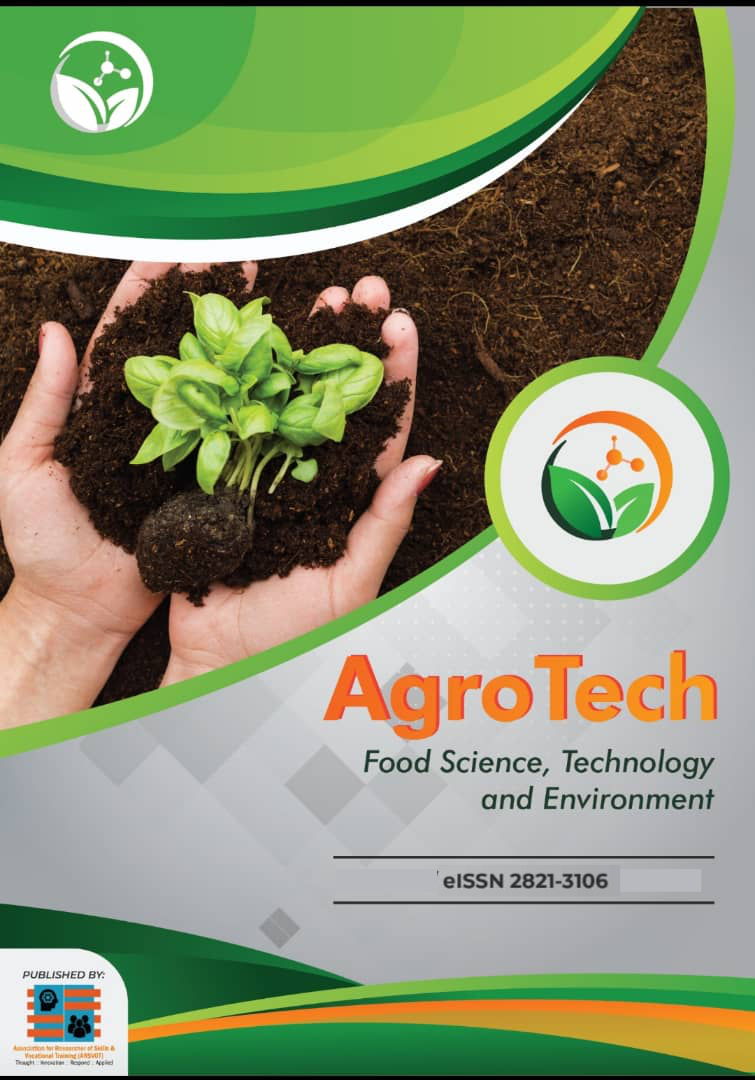Spatial Evaluation of Bagworm (Metisa plana) Infestation in an Oil Palm Plantation Using GIS
DOI:
https://doi.org/10.53797/agrotech.v2i2.10.2023Keywords:
Bagworm, oil palm, Geographical Information System (GIS), spatial analysis, pest infestation, kriging, precision agricultureAbstract
This study investigates the spatial distribution of bagworm (Metisa plana) infestation in an oil palm plantation in Felda Besout 2, Malaysia, using Geographic Information System (GIS) technology. A total of 57 systematically selected oil palm trees were sampled, and parameters including larval stages, elevation, and coordinates were recorded. The spatial interpolation method, ordinary kriging, was used to construct distribution maps that revealed infestation intensity across the area. The results indicated a high concentration of M. plana larvae in the western section of the plantation, predominantly in their late instar stages (6th and 7th). There was no significant correlation between infestation density and elevation (R² = 0.0144). GIS proved to be an effective tool for visualizing and managing pest outbreaks in precision agriculture. This technology enhances pest monitoring strategies and supports site-specific decision-making for integrated pest management (IPM) in oil palm plantations.
Downloads
References
Bakeri, S. A., Sahari, J., & Wahid, M. B. (2008). Leaf-eating caterpillars in Malaysian oil palm plantations. The Planter, 84(985), 89–103.
Basri, M. W., Norman, K., & Kevan, P. G. (2021). Reassessment of Metisa plana infestation patterns in oil palm plantations. Journal of Oil Palm Research, 33(1), 72–82. https://doi.org/10.21894/jopr.2021.0031
Cheong, Y. L., & Tey, C. C. (2012). Management of bagworm infestations in Malaysia: Challenges and strategies. The Planter, 88(1037), 15–24.
Chung, G. F., et al. (2020). Major insect pests and their management in oil palm plantations. MPOB Information Series. Malaysian Palm Oil Board.
Corley, R. H. V., & Tinker, P. B. (2016). The Oil Palm (5th ed.). Wiley-Blackwell.
Emmanuel, K., Bakhtawar, R., & Sharma, N. (2015). Integrated pest management of horticultural crops. Springer. https://doi.org/10.1007/978-81-322-2636-3
Esri. (2023). What is GIS? https://www.esri.com/en-us/what-is-gis
Halim, N. A., Sahari, J., & Kamarudin, N. (2017). Larval performance and feeding behaviour of Metisa plana. Journal of Oil Palm Research, 29(4), 511–520.
Jalani, B. S., Hasan, R., & Lim, K. H. (2022). Malaysian oil palm industry: Overview and future prospects. Oil Palm Bulletin, (85), 1–9.
Kamarudin, N., et al. (2012). Impact of bagworm infestation on oil palm yield in Malaysia. MPOB Report Series.
Khanal, S., & Lal, R. (2016). Precision agriculture in managing spatio-temporal variability of soil and crop productivity. Science of the Total Environment, 543, 610–624. https://doi.org/10.1016/j.scitotenv.2015.10.127
Liebhold, A. M., et al. (2013). Spatial synchrony in pest dynamics and the implications for management. Annual Review of Ecology, Evolution, and Systematics, 44, 317–341. https://doi.org/10.1146/annurev-ecolsys-110512-135703
Mazmiza, M. M., Sahari, J., & Kamarudin, N. (2011). Use of Bacillus thuringiensis (Bt) for bagworm control in Malaysian plantations. The Planter, 87(1020), 345–352.
Mohd Basri, M. W., & Kevan, P. G. (1995). Life cycle and feeding behavior of Metisa plana (Lepidoptera: Psychidae) under laboratory conditions. Journal of Oil Palm Research, 7(1), 1–10.
Mulla, D. J., & Khosla, R. (2016). Historical evolution and recent advances in precision farming. In Precision Agriculture for Sustainability (pp. 1–35). Burleigh Dodds Science Publishing.
Paramasivam, R., & Venkatramanan, V. (2019). Application of kriging in geospatial analysis of pest infestation. In V. Venkatramanan, S. Shah, & R. Prasad (Eds.), GIS-based technologies for sustainable development (pp. 147–160). Springer. https://doi.org/10.1007/978-981-13-9289-0_9
Ramlah, M. S., Basri, M. W., & Norman, K. (2007). Biology and control of Metisa plana Walker (Lepidoptera: Psychidae). Journal of Oil Palm Research, 19, 263–270.
Rival, A., & Levang, P. (2014). Palms of controversies: Oil palm and development challenges. CIFOR. https://doi.org/10.17528/cifor/004860
Sciarretta, A., & Trematerra, P. (2014). Spatio-temporal analysis of insect pests for precision IPM in agricultural ecosystems. Pest Management Science, 70(4), 647–660. https://doi.org/10.1002/ps.3691
Tuck, H. C., Basri, M. W., & Norman, K. (2011). Monitoring and control of Metisa plana using aerial surveys. Journal of Oil Palm Research, 23, 50–58.
Zhu, X. (2016). GIS for Environmental Applications: A practical approach. Routledge. https://doi.org/10.4324/9781315736902
Downloads
Published
How to Cite
Issue
Section
License
Copyright (c) 2023 arsvot

This work is licensed under a Creative Commons Attribution-NonCommercial-ShareAlike 4.0 International License.



